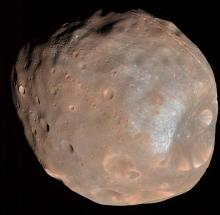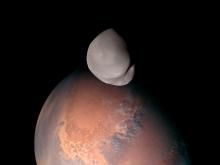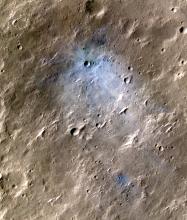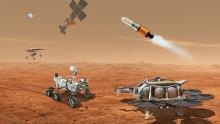You are here
Mars' Moons

Deimos is farther away and moves slowly from east to west. Deimos would look like a small dot of light in the sky. Phobos is slowly moving closer to Mars. In another 50 to 100 million years, it will crash into Mars.
Phobos is small, dark, and airless. And it's one of the driest bodies in the solar system.
That doesn't mean that Phobos is dull, though. Quite the contrary. Phobos survived a powerful impact that may have fractured its interior. The impact gouged a large crater, and may be responsible for a series of long, deep grooves that appear to radiate away from the crater.
If the meteor that created the crater had been a bit larger, it might have destroyed Phobos. Instead, many scientists think the impact cracked the moon's interior. The cracks could contain water ice. If so, Phobos could serve as a refueling station for manned Mars-exploration missions. But observations by several spacecraft indicate that there's less water at the surface of Phobos than in almost any other body in the solar system.
Deimos is covered by a powdery dust that could be several hundred feet deep. The tips of giant boulders peek above the dust like icebergs floating in a dark sea. The dust formed as the result of billions of years of meteorite impacts, which pulverized the tiny moon's surface.
Many scientists believe that Phobos and Deimos are asteroids that wandered close to Mars billions of years ago. The Martian atmosphere may have been thick enough to act as a brake, slowing the small bodies enough to trap them in orbit.
But other scientists say that the moons formed at the same time as Mars, or that they're the remnants of a larger moon that was shattered by a collision with a large meteor.
This document was last modified: September 13, 2008
Keywords
Teacher Copies
Request a free copy of The Solar System or Beyond the Solar System for your classroom. Bulk copies are available for $1.50 each in quantities of 30 or more. Shipping is included. Call 512-471-5285 for orders of 30 or more.
 The Astro Guides for the Solar System and Beyond the Solar System are supported by the National Aeronautics and Space Administration under Grant Nos. NNG04G131G and NAG5-13147, respectively.
The Astro Guides for the Solar System and Beyond the Solar System are supported by the National Aeronautics and Space Administration under Grant Nos. NNG04G131G and NAG5-13147, respectively.





